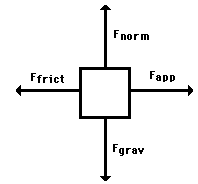Today, we continued our study of the transfering of energy.
1. Work = Force over distance
2. Heat = molecules colliding
3. Radiation = light waves
Energy always transfered from high--->low, E---->E
Potential Energy(gravity) - position
Potential Energy(elastic) - position
Kinetic Energy - motion
All three of the above types of energy: Mechanical energy - Any energy due to position or motion
Next, we experimented with the potential energy that rubberbands have, the force required to pull them, and the velocity of carts that are pulled and released against them.
We discovered that as the rubberbands were doubled and pulled back farther, their potential energy increased, thus causing higher outputs of energy with objects such as the carts.
In addition, we learned several new equations through our study of energy conservation:
PE(gravity) = (mass)(gravity)(height)
PE (elastic) = 1/2(elastic constant)(distance stretched squared)
KE = 1/2(mass)(velocity squared)
ME = PE x KE
Lastly, we had our postgame review:
1. E(trransformed) - work, heat, and radiation
2. E(stored) - PE(gravity), PE (elastic), kinetic energy
All three are of mechanical energy
3. Mechanical energy = position or motion
Real World Connection:
When buildings are being demolished, construction workers use machines to help tear them down.
For example, cranes use the position of their wrecking balls to destroy buildings due to their stored potential energy. By holding the wrecking ball in a high position and then letting it fall, enough energy is released to break down walls.















